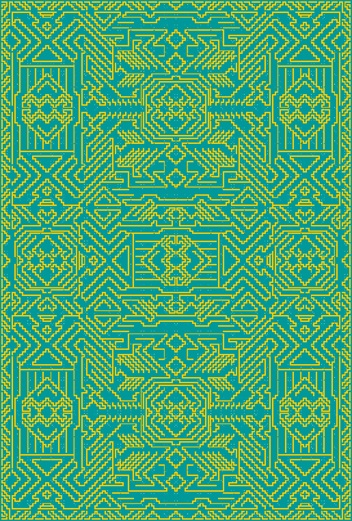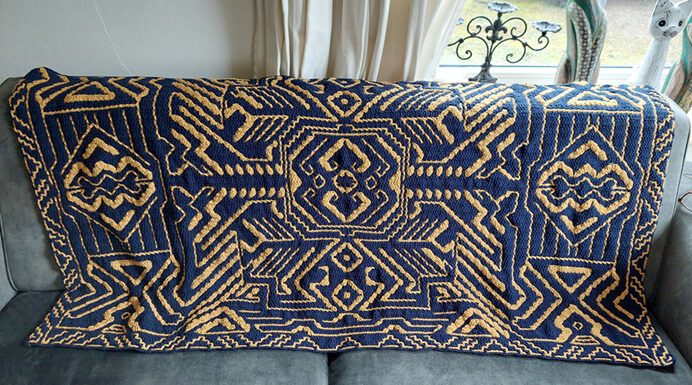This page is especially for the mosaic version of the CAL. Almost all information is on the page for the interlocking or interwoven page (click here), but for matters that specifically apply to the mosaic version, use this page.
Another version, why?
 The picture above of (half of) the blanket is not entirely correct! But the mosaic version I’m going to use for this CAL looks very similar to the design of the interlocking version. It’s also more to give you the ‘vibe’ or a sense of the ‘look’ of the colors that I show this picture on this page. And if you look at the picture on the left and compare it with the photo above, I think you will also notice that it looks very much like the blanket with the slanting lines. This version also served as input when I started making the version with the slanted lines.
The picture above of (half of) the blanket is not entirely correct! But the mosaic version I’m going to use for this CAL looks very similar to the design of the interlocking version. It’s also more to give you the ‘vibe’ or a sense of the ‘look’ of the colors that I show this picture on this page. And if you look at the picture on the left and compare it with the photo above, I think you will also notice that it looks very much like the blanket with the slanting lines. This version also served as input when I started making the version with the slanted lines.
I will explain here why I chose a different version. I also explained this on the interlocking page of this CAL, but I will repeat it here anyway.
I know you can apply diagonal lines to mosaic crochet. I also plan to add that to my range of patterns. But in the interlocking pattern, in addition to so-called open structures, closed structures are also used, which sometimes cause the tops of the stitches to ‘stretch’ quite a bit. I don’t know yet whether that will look nice with mosaic crochet. I simply haven’t had time to try that out yet (and expand my software accordingly), so I’m not going to offer it yet. I can’t promise that that will happen, because of course I’m not going to make that if it isn’t beautiful.
Now there are of course many fans of mosaic crochet, and I just hated not having them participate in the CAL! So I decided to grab one of the patterns from the 3 variations I had already made without the diagonal lines, namely variation 3. All variations of the pattern (both interlocking and mosaic) can be found here on Ravelry: click here. For the CAL I will provide you with the mosaic version of variation 3.
f you want to take on a challenge and know well how mosaic crochet pattern drawings work: you could take the instruction drawings of the pattern (new!!!, see the tutorials for slanted lines for interlocking) with the slanted lines and see if you can do something with it. Of course, you should read the instructions for interlocking for the back backwards. But this is for the real ‘die hards’ . If you are going to do this and you succeed (because it is possible, but the question is whether it will be nice!), please share this on the Facebook pages!
But has that been tested?
Well, I know that question will of course be asked. But I have used the software that I created myself (you can also read more about that on the interlocking page of this CAL) several times for my designs, and I have not received any complaints about it, so it is error-free. The software also counts exactly how many stitches there are in the design (and how many of them are double crochet, single crochet and chain stitches), so I can also calculate the yarn usage quite accurately.
The technique
The technique used is simply the overlay method for mosaic crochet. For the tutorial and how to read the pattern drawing (because I always put a little extra in there to help you work as quickly as possible without as few errors as possible) you can look at the website here: click here.
Yarn usage
Pay attention: this information is for the mosaic crochet version, variation 3!
For the blanket as shown above I used Alize Cotton Gold Solid. If you want to use different colors, then choose colors that have a good contrast.


You need 16 balls of Alize Cotton Gold Navy 58.
You need 12 balls of Alize Cotton Gold Honey 736.
This includes the edge, half of which is in color 1 and half in color 2. I calculated 15 cm for the beginning of each row and 15 cm for the end of each row.
The size of the blanket is about 150 cm x 220 cm.
The usage for the tutorial pieces is not(!) included, but you should have enough, I always have an extra margin for those who use more than me.
The balls are 100 grams and have 330 meters working length. It is a 55% cotton and 45% acrylics mix.
I used hooksize 4 mm.
Sample piece
Make a quick sample piece that is 30 stitches wide. Crochet back and forth with single crochets, working in the ‘normal’ way by picking up two loops when inserting your hook (so not in the mosaic way). I had 17 stitches and 22 rows on 10×10 cm.

